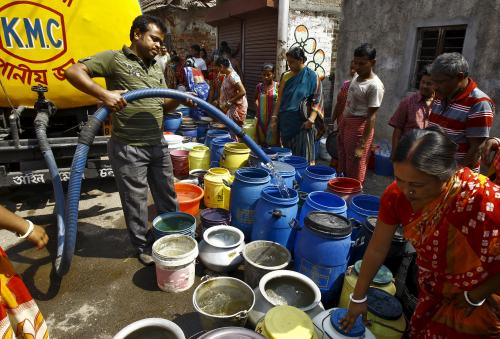Editor’s Note: This piece is adapted from Vanda Felbab-Brown’s new report, “Water Theft and Water Smuggling: Growing Problem or Tempest in a Teapot?”
Fresh water is vital for human survival and health, the production of food and energy, industrial activity, and the functioning of the entire global economy, as well as for the survival of other animals, plants, and natural ecosystems. Water scarcity, whatever its cause–natural catastrophes, pollution, poor water management, or theft and smuggling—can have grave consequences.
Water crimes: Controversy and scale
The topic is controversial in the first place, because there is no common definition as to what constitutes water theft and smuggling—or, for that matter, whether such phenomena exist at all. Water use regulations, including whether water use is priced or free, vary vastly around the world and often within a country, including within the United States.
There are two broad schools of thought on the use of and access to water (and hence on water theft and smuggling). One school defines water as a basic human right, and often opposes the pricing of water, particularly increases in prices. The other sees water as a commodity to which value needs to be assigned—contending that, like electricity, it needs to be priced properly to maintain its sustainability and efficient use. Members of the first school are deeply uncomfortable with the concepts and language of water theft and smuggling. Thus, legislation and regulations concerning water use can be politically divisive and explosive, since these opposite views can be strongly held, even within the same polity.
[T]he scale of water loss through mismanagement and outright water theft is staggering.
Leaving aside the legal controversies for a moment, the scale of water loss through mismanagement and outright water theft is staggering. According to the World Bank, some 48.6 million cubic meters of drinkable water escape daily from official supply networks, enough to provide water for 200 million people.
In developing countries, such water loss amounts to some 30 to 50 percent of all treated water. In Karachi and Delhi, such water leakages from old water pipes and outright water theft amounts to water loss of some 30 to 35 percent in each city. Water mafia networks divert water through illegal pipelines by drilling holes into official pipelines or setting up illegal hookups to water canals. In Karachi, water mafias also illegally tap into water hydrants and set up illegal wells and pipelines for industries. They fill up trucks and sell the water to industries and large businesses—some 70 percent of the stolen water!—as well as to the poor, at inflated prices. Illegal traders who operate 30 to 40 tankers earn as much as $16,000 a day.
In the South African city of Durban, some 35 percent of water is stolen or provided through illegal or unpaid connections. At a country-wide level, such water loss is estimated to be 37 percent. In Liberia’s capital of Monrovia, inadequate and deficient official water pipelines are further tapped by illegal water providers commonly referred to as Push-Push Boys, who sell the water at higher prices in the city as well as on its outskirts. At least 75 percent of Monrovia’s daily water supply of 6 million gallons is thus lost to theft and leaky pipes. The list goes on and on.
Threats from water theft and smuggling
Water theft and smuggling, just like unregulated or poorly-regulated use of water, can threaten the water security of licensed users. But it also ultimately threatens the water security of everyone—it leads to scarcity, and thus to rationing, increased prices, and potentially insufficient availability. The first and often most affected are the world’s poorest and most marginalized populations. Typically, slum residents around the world lack access to potable water. Many households need to rely on informal or outright illegal sources and actors for water distribution. These informal and illegal distribution systems are often inadequate and are provided at very high prices, with the paradoxical effect that the world’s poorest and most marginalized who most intensely lack water also often pay far more for it than the affluent and the middle class.
Poor water quality and high pollution, often exacerbated by unlicensed water delivery, can cause a variety of serious and potentially deadly diseases, whether cholera or typhoid or other longer-term illnesses.
Unpaid use of water—such as illegal hook-ups, siphoning of water, and illegal water pipelines—can also result in cities or countries not being able to collect sufficient payments for water use. Such large-scale delinquency and massive water theft and smuggling can produce inadequate resources for repairing, updating, and enlarging water distribution systems and for finding measures to cope with scarcity.
Illegal sourcing of water and failures to pay for water use frequently lead to water scarcity, which hurts agriculture and undermines food security by compromising both crop production and grazing. Similarly, industries regularly overuse water and fail to pay for their water consumption, thus engaging in water theft. Subsequent water shortages may severely affect these and other industries, thus triggering even larger negative economic effects.
Thirsty yet? Here’s what can be done
The purpose of water regulation is to ensure long-term water sustainability and compatibility of water use across society, by all actors, and among competing uses (human consumption, agriculture, industry, and energy), as well as to ensure the preservation or biodiversity of natural ecosystems. Strict legal compliance does not guarantee the sustainable and efficient use of water, of course. If the regulatory system is inadequate, all kinds of deficiencies can pervade water use. Nor does strict legality of water distribution necessarily signify equitable access to water.
Assigning property rights and pricing water is insufficient if enforcement is absent or inadequate.
However, without legal compliance, it is difficult to devise an effective regulatory system. After all, insufficient pricing and cost-avoidance can, and often do, lead to overuse and depletion—and eventually result in the degradation of water treatment and supply facilities. All these problems compound the lack of water access for the poor and marginalized, ultimately drying up even their informal, and sometimes outright illegal, water sourcing and distribution. Assigning property rights and pricing water is insufficient if enforcement is absent or inadequate. Although cross-border water smuggling has so far not materialized on any large scale, it could become prevalent in the future, with all of its political, conflict-related, and geostrategic implications.
In my new report, I analyze water theft and smuggling around the world and their political and regulatory implications. And controversially, I embrace punitive enforcement of water regulations—such as against unpaid use, theft, and smuggling—as an approach that should increasingly be explored and adopted. That does not mean that poor, marginalized urban and rural populations—whom governments fail to provide with legal public water distribution —should be simply cut off. Indeed, establishing a legal water supply, and perhaps providing it for free up to the minimum amount a person needs for healthy survival (50 liters per day) needs to precede enforcement actions. Establishing such a legal supply can include legalizing some illegal water suppliers, such as by giving them licenses if they obey certain regulations. However, it also means cracking down on large abusers of water regulations, such as major industries and agricultural actors, that use and overuse water and do not pay for it.
The Brookings Institution is committed to quality, independence, and impact.
We are supported by a diverse array of funders. In line with our values and policies, each Brookings publication represents the sole views of its author(s).











Commentary
Stealing water
March 23, 2017